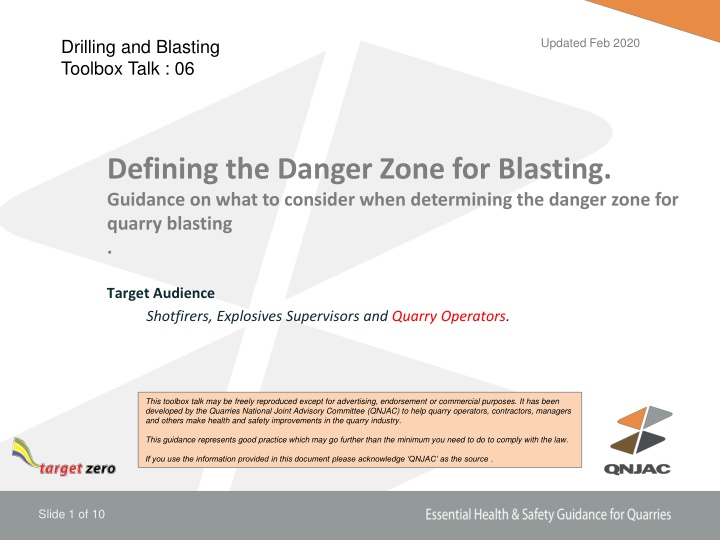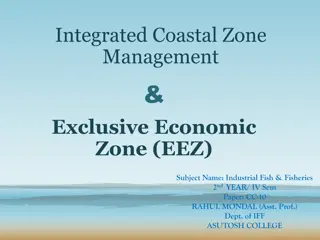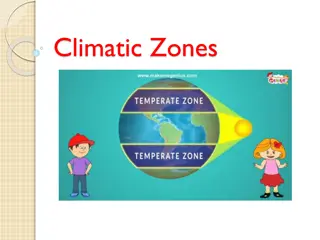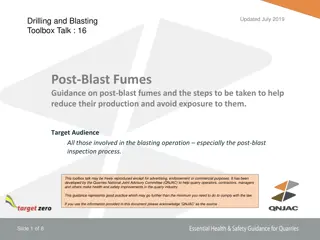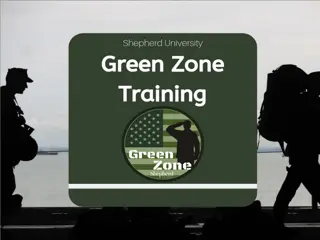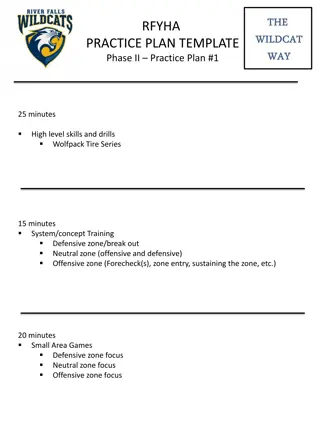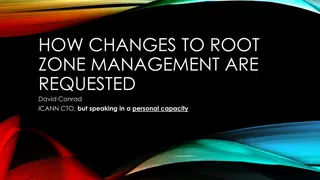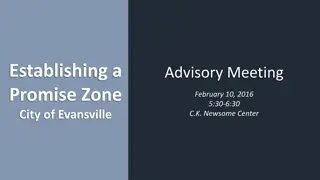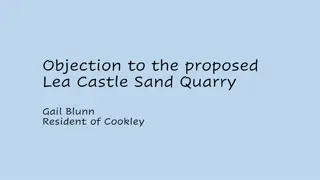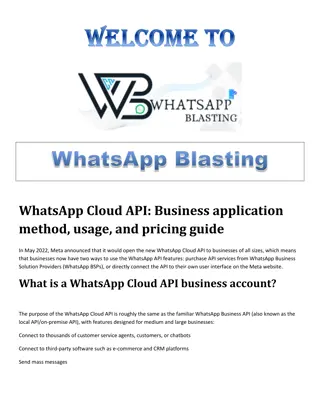Defining the Danger Zone for Quarry Blasting
Blasting operations in quarries require a declared danger zone, with rules and procedures to determine its extent. This includes areas outside the quarry boundary that may need to be included. The danger zone is where no personnel should be present during a blast, with provisions for safe shelters or refuges. Ensuring the establishment and operation of safe refuges is crucial for the safety of quarry personnel and visitors. The danger zone must be large enough and controlled effectively to mitigate risks.
Download Presentation

Please find below an Image/Link to download the presentation.
The content on the website is provided AS IS for your information and personal use only. It may not be sold, licensed, or shared on other websites without obtaining consent from the author.If you encounter any issues during the download, it is possible that the publisher has removed the file from their server.
You are allowed to download the files provided on this website for personal or commercial use, subject to the condition that they are used lawfully. All files are the property of their respective owners.
The content on the website is provided AS IS for your information and personal use only. It may not be sold, licensed, or shared on other websites without obtaining consent from the author.
E N D
Presentation Transcript
Updated Feb 2020 Drilling and Blasting Toolbox Talk : 06 Defining the Danger Zone for Blasting. Guidance on what to consider when determining the danger zone for quarry blasting . Target Audience Shotfirers, Explosives Supervisors and Quarry Operators. This toolbox talk may be freely reproduced except for advertising, endorsement or commercial purposes. It has been developed by the Quarries National Joint Advisory Committee (QNJAC) to help quarry operators, contractors, managers and others make health and safety improvements in the quarry industry. This guidance represents good practice which may go further than the minimum you need to do to comply with the law. If you use the information provided in this document please acknowledge QNJAC as the source . Slide 1 of 10
Defining the danger zone for blasting 1. Introduction All blasting operations must have a declared danger zone. The rules for shotfiring operations should include a procedure for the determination of the danger zone The extent of the danger zone may be shown on a suitable plan and is the recommended means, but must be included in the Blast Specification. Areas outside the quarry boundary may need to be included in the danger zone Slide 2 of 10
Defining the danger zone for blasting 1. Introduction The danger zone is an area in which there must be no personnel during the blast. The inside of a Shotfiring Shelter or a Safety Refuge are not considered to be part of the danger zone. Photo courtesy of Aggregate Industries Slide 3 of 10
Defining the danger zone for blasting 1. Introduction Some quarries may also have provision for a Safe Refuge within the danger zone where it is safe for the quarry personnel and other visitors to shelter during the blasting process. It is important that the establishment of a Safe Refuge is the subject of a detailed Risk Assessment and that the structure employed is of sufficient strength to prevent the ingress of flyrock. Equally important is that the operation of such a refuge is covered by the shotfiring rules especially Appointment of a sentry to control the refuge Communication between the refuge sentry and the shotfirer Slide 4 of 10
Defining the danger zone for blasting 2. Basics The danger zone needs to be as large as necessary In the example below the danger zone extends outside of the quarry boundary and includes access land and a public footpath which would need to be controlled Slide 5 of 10
Defining the danger zone for blasting 2. Basics The danger zone needs to be controllable Sentries must be able to see / control all parts of the danger zone that they are responsible for. For more information on sentry duties see TBT 07 Controlling The Danger Zone and the Duties of Sentries Slide 6 of 10
Defining the danger zone for blasting 3. Factors to consider Ask yourself Has the quarry had any issues in the past ? Have there been any issues loading the blast holes ? Are you satisfied with the size of the danger zone ? The QUARRY Operator, Explosives Supervisor and Shotfirer should agree on the determined danger zone and sentry positions. The danger zone will need to be carefully assessed especially when there have been changes in normal blasting operations or different areas of the quarry being worked. Slide 7 of 10
Defining the danger zone for blasting 4. Public areas The location of roads, footpaths and the quarry boundary should not determine the limit of the danger zone If the determined danger zone extends outside of the quarry boundary then consideration needs to be given on how this area can be controlled Public footpaths and road will need sentries where they enter and leave the danger zone. It is likely a sentry or other person will need to travel a footpath or road to make sure nobody is present before firing Special consideration may need to be given to any structures within the danger zone For example : buildings, tunnels, etc. Slide 8 of 10
Defining the danger zone for blasting 5. Key Points The danger zone should be as big as necessary The danger zone needs to be controllable If in doubt then make the danger zone larger The danger zone should not be one of convenience Slide 9 of 10
